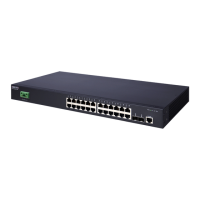Chapter 24
| Multicast Filtering Commands
IGMP Snooping
– 650 –
Command Usage
◆ By default, general query messages are flooded to all ports, except for the
multicast router through which they are received.
◆ If general query suppression is enabled, then these messages are forwarded
only to downstream ports which have joined a multicast service.
Example
Console(config)#ip igmp snooping vlan 1 general-query-suppression
Console(config)#
ip igmp snooping vlan
immediate-leave
This command immediately deletes a member port of a multicast service if a leave
packet is received at that port and immediate-leave is enabled for the parent VLAN.
Use the no form to restore the default.
Syntax
ip igmp snooping vlan vlan-id immediate-leave [by-host-ip]
vlan-id - VLAN ID (Range: 1-4094)
by-host-ip - Specifies that the member port will be deleted only when
there are no hosts joining this group.
Default Setting
Disabled
Command Mode
Global Configuration
Command Usage
◆ If immediate-leave is not used, a multicast router (or querier) will send a group-
specific query message when an IGMPv2/v3 group leave message is received.
The router/querier stops forwarding traffic for that group only if no host replies
to the query within the timeout period. (The timeout for this release is defined
by Last Member Query Interval (fixed at one second) * Robustness Variable
(fixed at 2) as defined in RFC 2236.
◆ If immediate-leave is used, the switch assumes that only one host is connected
to the interface. Therefore, immediate leave should only be enabled on an
interface if it is connected to only one IGMP-enabled device, either a service
host or a neighbor running IGMP snooping.
◆ If the “by-host-ip” option is used, the router/querier will not send out a group-
specific query when an IGMPv2/v3 leave message is received. But will check if
there are other hosts joining the multicast group. Only when all hosts on that
port leave the group will the member port be deleted.
